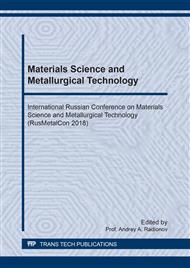p.901
p.906
p.913
p.921
p.928
p.934
p.939
p.945
p.950
Effect Study of Thermal Cutting Methods on the Edge’s Microstructure of High-Strength Steel Grade S700MC
Abstract:
The paper presents the results of metallographic studies of laser and plasma cutting methods of high-strength steel for the purpose of its application for the preparation of sample edges without subsequent machining. It is shown that as a result of the thermal and physical-chemical processes in heat affected one (HAZ), there is a change in the phase and chemical composition of the metal. The depth of the HAZ is changed from 261 μm to 337 μm. The maximum hardness at the cutting edge is 410 HV10. On the surface after the laser cutting there is an oxidized layer of metal, saturated with oxygen, nitrogen and other gases as a result of contact with the oxygen jet and the surrounding air; its thickness is hundredths or even thousandths of a millimeter. A feature of the plasma cutting method is the formation of a deeper oxide layer on the surface with a thickness of 9...14 μm, in contrast to the laser cutting method. The analysis of existing research to improve the technology of repair welding of low-carbon steel is performed. The obtained results can be used in the development of high-strength steel grades welding technology in terms of preparation of edges for welding using thermal cutting methods, which are currently quite conservative.
Info:
Periodical:
Pages:
928-933
Citation:
Online since:
February 2019
Authors:
Keywords:
Price:
Сopyright:
© 2019 Trans Tech Publications Ltd. All Rights Reserved
Share:
Citation:


